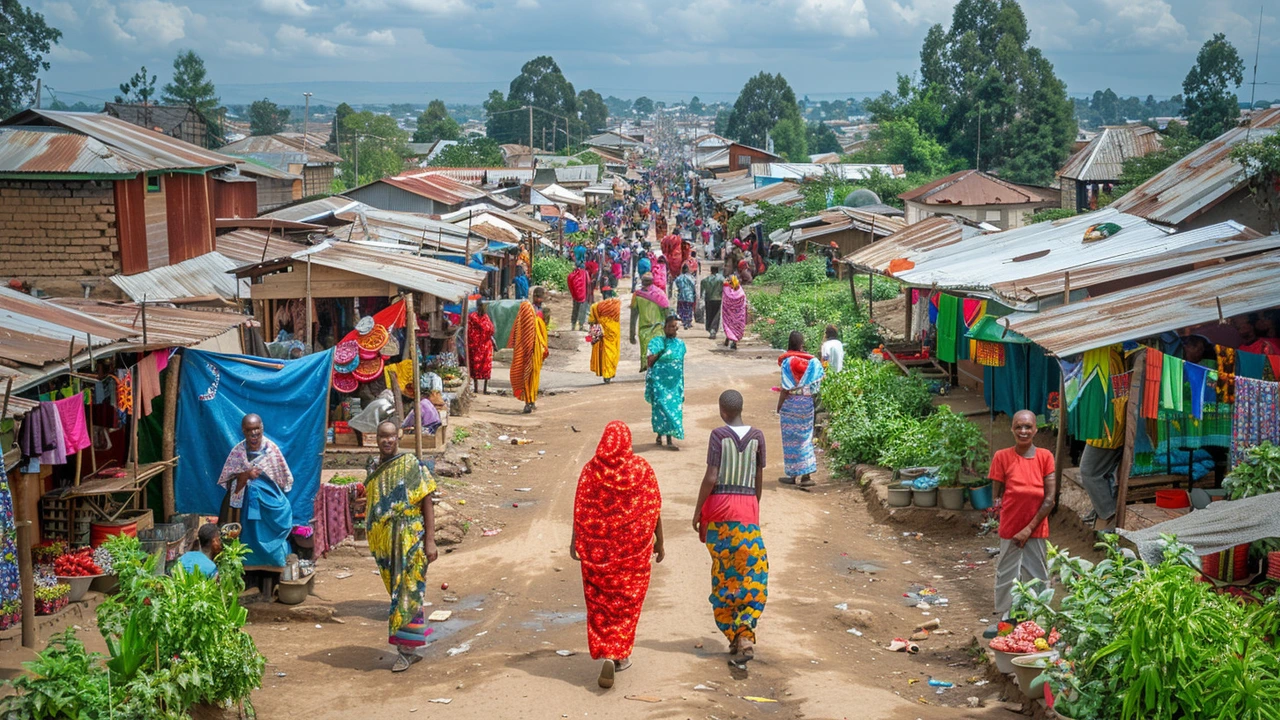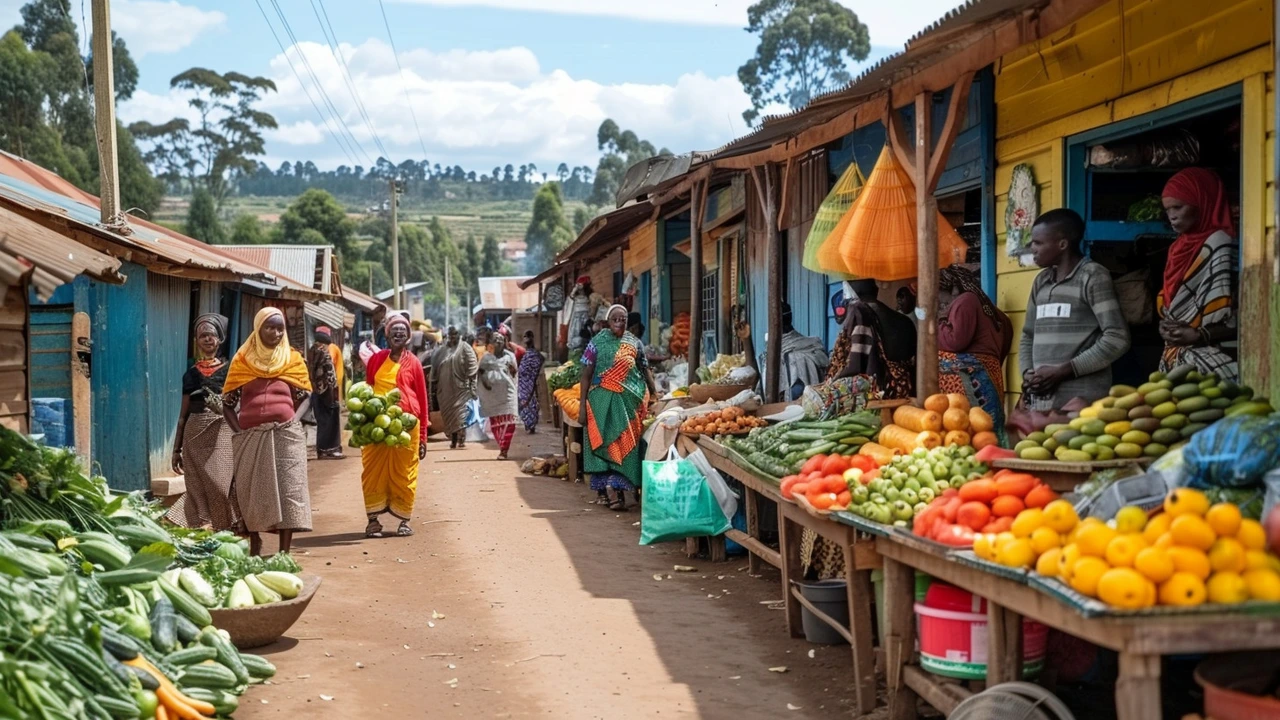Income levels are a vital indicator of economic health. In Ethiopia, a country of stunning landscapes and rich history, understanding average income goes beyond numbers and statistics. It's about delving into the real-world implications for the everyday lives of people.
Let's dive into what the average Ethiopian earns, the factors at play, and how these income levels shape daily life and living standards across this fascinating country.
- Current Statistics on Average Income
- Factors Influencing Income Variations
- Regional and Sectoral Differences
- Daily Life and Living Standards
Current Statistics on Average Income
Understanding the average income in Ethiopia begins with grasping the economic landscape of the country. Ethiopia's economy has been growing steadily over the past decade, primarily driven by agriculture, services, and a burgeoning manufacturing sector. According to the World Bank, the national GDP per capita was approximately $900 in 2023. This figure, however, doesn't paint the full picture of income distribution and disparity.
In urban areas like Addis Ababa, incomes are generally higher compared to rural regions. The average monthly salary in the capital can range from 8,000 to 12,000 Ethiopian Birr (ETB), translating to roughly $150 to $230 USD. In contrast, rural areas often see significantly lower incomes due to the agrarian nature of the economy. On average, a rural household might earn around 3,500 ETB per month, which is about $65 USD.
"Ethiopia's strides in economic growth are commendable, but income inequality remains a pressing challenge," says a report by the International Monetary Fund. "Addressing this will require coordinated policy efforts from both the government and private sector."
It's also important to note the informal sector plays a significant role in the Ethiopian economy. Many people engage in small-scale trade, crafts, and services, which may not always be reflected in formal salary statistics. The informal sector can account for up to 50% of employment in the country, which has implications for accurately measuring the average income.
While assessing average income, one should also consider the impact of inflation. Ethiopia has experienced moderate inflation rates in recent years, affecting the real purchasing power of incomes. As of 2023, the inflation rate hovered around 20%, meaning that even though nominal incomes might seem to rise, the actual purchasing power could remain stagnant if essential goods and services become more expensive.
Despite these challenges, there are positive trends as well. The Ethiopian government has been investing heavily in infrastructure, aiming to improve road networks, telecommunications, and energy supply. These projects are expected to create jobs and boost incomes across various sectors. Additionally, foreign direct investment (FDI) has been increasing, particularly in manufacturing and services, promising new employment opportunities and potentially higher salaries.
Sectoral Income Differences
Breaking down income statistics by sector provides more nuanced insights. Employees in the civil service and banking sectors often have higher average incomes compared to those in agriculture or retail. For instance, a mid-level professional in the banking sector could earn up to 20,000 ETB ($380 USD) monthly, while a skilled agricultural worker might earn less than half of this amount.
Moreover, the education and health sectors have experienced modest wage growth, thanks to governmental policies aimed at retaining skilled professionals. A teacher or nurse, depending on their experience level and qualifications, might earn between 7,000 ETB and 15,000 ETB per month. Yet, it's crucial to consider benefits such as housing allowances or subsidized healthcare, which are often part of the compensation package but not always reflected in the basic salary figures.
Gender Pay Gap
Another critical aspect of the income statistics is the gender pay gap. Despite progress in gender equality, Ethiopian women often earn less than their male counterparts for similar roles. Addressing this disparity is integral for fostering inclusive economic growth.
In summary, the current statistics on average income in Ethiopia reflect a dynamic yet challenging economic environment. While urban areas and certain sectors offer relatively higher incomes, many regions and occupations still face significant income constraints. Continuous efforts in economic policy and investment are key to improving these statistics and enhancing the living standards for all Ethiopians.

Factors Influencing Income Variations
Income variations in Ethiopia stem from a myriad of elements that shape the economic landscape. To start, educational attainment plays a significant role. Ethiopians with higher education degrees usually earn substantially more than those with primary or secondary education. The disparity emerges because higher education often provides access to skilled jobs in industries like finance, tech, and healthcare, which tend to pay more.
Another factor is geographic location. Urban areas, particularly Addis Ababa, offer higher wages compared to rural regions. This income gap appears due to the concentration of businesses, industries, and services in cities, which creates a higher demand for labor and subsequently, higher wages. In rural areas, agriculture dominates, and wages tend to be lower. There is also the issue of limited access to educational and professional opportunities in these areas.
Ethiopia's economic diversity also influences income variations. Sectors like technology and communications have seen a surge in growth, offering competitive salaries, especially for tech-savvy youth. In contrast, traditional sectors such as agriculture and textiles often provide lower wages because of less profit margins and minimal scope for industrial advancement. Government initiatives and foreign investments in non-traditional sectors have started shifting this balance, but the impact is still unfolding.
Moreover, gender inequality impacts income. On average, women earn less than men in Ethiopia. Cultural and societal norms contribute to this gap, influencing the types of jobs women can access and the salary levels they achieve. Efforts are underway to address these disparities, but progress remains slow. Initiatives to promote women's education and professional training are vital in bridging this income gap.
"Addressing income disparities requires a multifaceted approach, including improving access to education, creating job opportunities in diverse sectors, and tackling societal norms." – The Ethiopian Economic Association
Further compounding these variations is work experience. Individuals with extensive experience in their fields generally earn more than those who are just starting. This principle aligns with global employment trends but is particularly noticeable in Ethiopia, where experienced professionals often occupy management or specialized roles that command higher wages.
Government policy also influences income variations. Policies aimed at improving infrastructure, education, and healthcare have long-term impacts on income levels. Subsidies, tax incentives for businesses, and investment in public services can enhance earning potential, although these benefits sometimes take years to materialize.
Lastly, the unpredictable factor of global economic conditions cannot be ignored. Factors like commodity prices, global trade dynamics, and foreign investment impact Ethiopia's economy. For instance, fluctuations in coffee prices, one of Ethiopia's major exports, directly affect national income levels and individual earnings within this sector.
Understanding these factors provides a clearer picture of the diverse and complex reasons behind income variations in Ethiopia. Recognizing the interplay of education, location, sector, gender, experience, policy, and global economics helps us grasp why incomes differ so markedly across the country.

Regional and Sectoral Differences
Ethiopia, with its vast and varied landscape, showcases significant diversity not only in its geography but also in its economic landscape. The average income can differ dramatically from one region to another and across various sectors. For instance, urban areas like Addis Ababa typically enjoy higher incomes compared to rural regions where agriculture is the mainstay.
In Addis Ababa, the capital city, professionals working in technology, finance, and international organizations often earn considerably more than those in traditional sectors. A software developer in Addis might earn up to 20,000 Ethiopian Birr (ETB) per month, while an agricultural worker in the rural Oromia region might make only around 2,500 ETB monthly. This stark contrast illustrates the economic divide between urban and rural areas.
Education and industry play large roles in this disparity. Regions with stronger educational institutions and higher employment rates in industrial sectors tend to show higher average incomes. For example, Dire Dawa, an industrial hub, generally offers better-paying jobs compared to the pastoral regions of Afar.
Sectoral differences are equally striking. The tech industry, burgeoning with startups and foreign investments, offers lucrative salaries and benefits. In contrast, traditional sectors like agriculture, which employ a significant portion of Ethiopia’s population, tend to offer lower wages. According to the World Bank, agriculture contributes to approximately 32% of Ethiopia's GDP but pays the least among all sectors.
"Ethiopia's economic landscape is marked by a considerable urban-rural income gap, largely due to differing levels of access to education and industry development," says a report by the Ethiopian Economics Association.
Trade and services also show promising income potential. In cities like Addis Ababa and Hawassa, those engaged in commerce and hospitality can expect higher earnings due to the burgeoning tourism and business travel. A manager in a mid-sized hotel might earn up to 15,000 ETB per month. Conversely, healthcare workers in smaller healthcare facilities in rural regions might earn considerably less, despite the vital nature of their services.
Economic policies and investments play crucial roles in shaping these differences. Government efforts to bolster industrial parks and enhance agricultural productivity are aimed at reducing these income disparities. Hawassa Industrial Park, for example, has created numerous job opportunities, boosting local incomes significantly.

Daily Life and Living Standards
Life in Ethiopia revolves around its rich culture and traditions, which deeply influence daily living standards. The average Ethiopian's income may seem modest by global standards, but understanding how this income interacts with the cost of living within the country provides a clearer picture of daily life.
Housing varies significantly between urban and rural areas. In cities like Addis Ababa, rental costs can be relatively high, eating up a substantial portion of monthly incomes. Yet, rural areas often see families living in self-built homes, with lower living expenses but limited amenities compared to urban settings. These differences lead to varying standards of living across different regions.
Food plays a central role in Ethiopian life. The traditional injera with various stews, vegetables, and meats, is a staple. Food costs can be manageable, especially when relying on local markets. One fascinating fact is that despite fluctuating incomes, communal eating and sharing food are common practices that bolster community ties and resilience.
Education and health are crucial pillars. Public schools are accessible, but the quality may vary, pushing those who can afford it towards private institutions. Healthcare access is improving, with efforts from both the government and international organizations aiming to enhance services, especially in rural areas where facilities were previously scarce.
"Improving healthcare and education in Ethiopia is an ongoing process that requires significant investment and commitment, but it's essential for elevating living standards." - United Nations Development Programme (UNDP)
Public transportation in cities is affordable but often crowded. The expansion of the light rail transit in Addis Ababa has been a significant improvement, providing a more reliable and faster mode of travel. In rural areas, transportation largely relies on minibuses, shared taxis, and sometimes even animal-drawn carts.
Additionally, access to technology and the internet is spreading, albeit at different rates. Many urban households have access to the internet, aiding in education, business, and staying connected. However, rural areas often face challenges with connectivity and power supply, which can hinder development.
Various income-generating activities are undertaken by families to supplement their earnings. Agriculture remains a backbone for many, with coffee being a significant cash crop. In urban centers, small businesses and informal trade provide employment opportunities, contributing to the household income.
It's also essential to recognize the role of remittances from Ethiopians abroad, which provide financial support to families, enhancing their ability to afford better education, healthcare, and housing. This external income is a crucial element of many households' financial stability.
In sum, the living standards in Ethiopia are influenced by diverse factors, from geographical location to economic activities and cultural practices. While challenges persist, the resilience and communal spirit of the Ethiopian people play a significant role in shaping everyday life, creating a unique tapestry of experiences that define the country's character.

 Using USD in Ethiopia: What Travelers Need to Know
Using USD in Ethiopia: What Travelers Need to Know
 Top High-Paying Occupations You Should Consider
Top High-Paying Occupations You Should Consider
 Can US Citizens Work in Ethiopia? Understanding Salaries and Opportunities
Can US Citizens Work in Ethiopia? Understanding Salaries and Opportunities
 Discovering Ethiopia's Rich Cultural and Natural Treasures
Discovering Ethiopia's Rich Cultural and Natural Treasures
 Pharmacist Salary in the USA: What You Need to Know
Pharmacist Salary in the USA: What You Need to Know
Frankie Mobley
May 30, 2024 AT 17:37Thanks for sharing these stats. The average income in Ethiopia varies a lot between cities and villages. In Addis Ababa you can see salaries around 8,000‑12,000 ETB while many rural households earn about 3,500 ETB. The informal sector adds another layer because many people work in small trade or crafts that aren’t captured in official numbers. Inflation around 20 % also means that even if the pay looks higher, the buying power stays low. Investments in roads and energy are a good sign for future jobs, especially in manufacturing. Keep an eye on how foreign direct investment may lift wages in the coming years. Overall, the picture is mixed – growth is there but the gap between rich and poor remains wide. If you’re looking at a specific region, checking local surveys can give a clearer view.
ashli john
May 31, 2024 AT 21:23Great job breaking down the numbers I love how you kept it clear and upbeat It really helps anyone trying to understand the bigger picture Keep up the good work.
Kim Chase
June 2, 2024 AT 01:10Thats a solid overview but lets also think about how education stil plays a big role People with higher degrees defnitely make more money And its not just cities even some towns are pullin up thanks to new tech hubs Also gender pay gap is still real many women earn less for same work It would be cool if future posts dived deeper into those topics
David Werner
June 3, 2024 AT 04:57The numbers are a front for a hidden agenda.
Paul KEIL
June 4, 2024 AT 08:43While the macro data looks promising the underlying structural inefficiencies remain unaddressed the elasticity of labor markets in peripheral zones is suboptimal and the fiscal multiplier associated with infrastructure spend is still ambiguous without granular input‑output analysis
Horace Wormely
June 5, 2024 AT 12:30There are several grammatical issues in the post for example “Ethiopia’s strides” should be “Ethiopia’s strides are” and the phrase “the average monthly salary in the capital can range from 8,000 to 12,000 Ethiopian Birr” would read better as “the average monthly salary in the capital ranges from 8,000 to 12,000 Ethiopian Birr”. Also commas are missing before non‑restrictive clauses such as “which is about $65 USD”. Proper parallel structure would improve readability.
christine mae cotejo
June 6, 2024 AT 16:17Reading the discussion reminds me of how complex the Ethiopian economy truly is and how statistics can sometimes hide more than they reveal. The average income figure alone does not capture the nuanced realities faced by families in both urban and rural settings. When the World Bank reports a GDP per capita of $900 it is a macro snapshot that masks the daily struggles of a household purchasing basic staples like injera and beans. Inflation hovering around twenty percent erodes purchasing power and forces many to allocate a larger share of income to food and fuel. Moreover, the informal sector, which employs up to half of the workforce, often operates outside the formal reporting mechanisms, leading to underestimation of true earnings. Regional disparities further compound the issue; while a software developer in Addis may earn twenty thousand birr, a farmer in Oromia might survive on two thousand five hundred birr. These gaps are not merely numerical but reflect differences in access to education, healthcare, and infrastructure. Government investment in industrial parks and road networks promises to create jobs, yet the benefits will be uneven if policies do not specifically target the most vulnerable populations. It is also essential to consider the gender pay gap; women frequently earn less than men for comparable positions, which perpetuates broader socioeconomic inequality. Remittances from abroad provide a critical lifeline for many households, supplementing modest local wages and enabling better education and healthcare outcomes. However, reliance on external income can also introduce volatility when global economic conditions shift. The coffee market, a major export, illustrates how commodity price fluctuations directly affect rural incomes. In addition, the burgeoning tech sector offers new opportunities but requires a skilled workforce that is currently limited by educational resources. Addressing these multifaceted challenges will necessitate coordinated efforts across government, private sector, and civil society. Only through comprehensive policies that improve education, health, and market access can the average income figures translate into real improvements in living standards. In sum, while the headline numbers are encouraging, a deeper dive reveals a tapestry of interlinked factors that must be addressed holistically.
Douglas Gnesda
June 7, 2024 AT 20:03Awesome thread folks! The data you’ve all dissected shows a classic case of divergent growth trajectories across sectors – from high‑tech to subsistence agriculture. From a macro‑economic perspective, the elasticity of labor supply in urban hubs is driving wage premiums, while the marginal productivity in rural zones remains constrained. It’s fascinating how FDI inflows are spurring a shift in the industrial composition, creating new high‑skill niches that demand advanced training. I’d love to see more granular surveys on household consumption patterns to overlay real purchasing power on top of nominal earnings. Also, let’s keep an eye on policy levers like tax incentives for SMEs; they could be a game‑changer for the informal sector. Keep the insights coming – this conversation is exactly the kind of collaborative analysis we need to push the narrative forward.